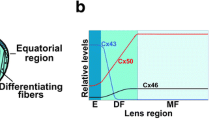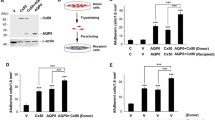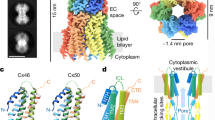Abstract
The lens is an avascular organ that transmits and focuses light images onto the retina. Intercellular gap junction channels, formed by at least three different connexin protein subunits, α1 (connexin43 or Gja1), α3 (connexin46 or Gja3) and α8 (connexin50 or Gja8), are utilized to transport metabolites, ions and water in the lens. In combination with physiological and biochemical analyses, recent genetic studies have significantly improved our understanding about the roles of diverse gap junction channels formed by α3 and α8 connexin subunits during lens development and cataract formation. These studies have demonstrated that α3 connexin is essential for lens transparency while α8 connexin is important for lens growth and transparency. Diverse gap junction channels formed by α3 and α8 subunits are important for the differentiation, elongation and maturation of lens fiber cells. Aberrant gap junction communication, caused by alterations of channel assembly, channel gating or channel conductance, can lead to different types of cataracts. These findings provide some molecular insights for essential roles of connexins and gap junctions in lens formation and the establishment and maintenance of lifelong lens transparency.


Similar content being viewed by others
References
Addison PK, Berry V, Holden KR, Espinal D, Rivera B, Su H, Srivastava AK, Bhattacharya SS (2006) A novel mutation in the connexin 46 gene (GJA3) causes autosomal dominant zonular pulverulent cataract in a Hispanic family. Mol Vis 12:791–795
Baldo GJ, Gong X, Martinez-Wittinghan FJ, Kumar NM, Gilula NB, Mathias RT (2001) Gap junctional coupling in lenses from alpha(8) connexin knockout mice. J Gen Physiol 118:447–456
Baruch A, Greenbaum D, Levy ET, Nielsen PA, Gilula NB, Kumar NM, Bogyo M (2001) Defining a link between gap junction communication, proteolysis, and cataract formation. J Biol Chem 276:28999–29006
Bassnett S (2004) Lens fiber differentiation. In: Lovicu FJ, Robinson ML (eds), Development of the Ocular Lens. Cambridge: Cambridge University Press, pp 214–244
Beyer EC, Kistler J, Paul DL, Goodenough DA (1989) Antisera directed against connexin43 peptides react with a 43-kD protein localized to gap junctions in myocardium and other tissues. J Cell Biol 108:595–605
Chang B, Wang X, Hawes NL, Ojakian R, Davisson MT, Lo WK, Gong X (2002) A Gja8 (Cx50) point mutation causes an alteration of alpha 3 connexin (Cx46) in semi-dominant cataracts of Lop10 mice. Hum Mol Genet 11:507–513
Fleishman SJ, Unger VM, Yeager M, Ben-Tal N (2004) A Calpha model for the transmembrane alpha helices of gap junction intercellular channels. Mol Cell 15:879–888
Gao J, Sun X, Martinez-Wittinghan FJ, Gong X, White TW, Mathias RT (2004) Connections between connexins, calcium, and cataracts in the lens. J Gen Physiol 124:289–300
Gong X, Baldo GJ, Kumar NM, Gilula NB, Mathias RT (1998) Gap junctional coupling in lenses lacking alpha3 connexin. Proc Natl Acad Sci USA 95:15303–15308
Gong X, Li E, Klier G, Huang Q, Wu Y, Lei H, Kumar NM, Horwitz J, Gilula NB (1997) Disruption of alpha3 connexin gene leads to proteolysis and cataractogenesis in mice. Cell 91:833–843
Goodenough DA (1992) The crystalline lens. A system networked by gap junctional intercellular communication. Semin Cell Biol 3:49–58
Hansen L, Yao W, Eiberg H, Funding M, Riise R, Kjaer KW, Hejtmancik JF, Rosenberg T (2006) The congenital “ant-egg” cataract phenotype is caused by a missense mutation in connexin46. Mol Vis 12:1033–1039
Kumar NM, Gilula NB (1996) The gap junction communication channel. Cell 84:381–388
Martinez-Wittinghan FJ, Sellitto C, White TW, Mathias RT, Paul D, Goodenough DA (2004) Lens gap junctional coupling is modulated by connexin identity and the locus of gene expression. Invest Ophthalmol Vis Sci 45:3629–3637
Mathias RT, Rae JL, Baldo GJ (1997) Physiological properties of the normal lens. Physiol Rev 77:21–50
Piatigorsky J (1981) Lens differentiation in vertebrates. A review of cellular and molecular features. Differentiation 19:134–153
Rong P, Wang X, Niesman I, Wu Y, Benedetti LE, Dunia I, Levy E, Gong X (2002) Disruption of Gja8 (alpha8 connexin) in mice leads to microphthalmia associated with retardation of lens growth and lens fiber maturation. Development 129:167–174
Sellitto C, Li L, White TW (2004) Connexin50 is essential for normal postnatal lens cell proliferation. Invest Ophthalmol Vis Sci 45:3196–3202
Unger VM, Kumar NM, Gilula NB, Yeager M (1999) Three-dimensional structure of a recombinant gap junction membrane channel. Science 283:1176–1180
Vanita V, Hennies HC, Singh D, Nurnberg P, Sperling K, Singh JR (2006) A novel mutation in GJA8 associated with autosomal dominant congenital cataract in a family of Indian origin. Mol Vis 12:1217–1222
White TW (2002) Unique and redundant connexin contributions to lens development. Science 295:319–320
White TW, Bruzzone R, Wolfram S, Paul DL, Goodenough DA (1994) Selective interactions among the multiple connexin proteins expressed in the vertebrate lens: the second extracellular domain is a determinant of compatibility between connexins. J Cell Biol 125:879–892
White TW, Goodenough DA, Paul DL (1998) Targeted ablation of connexin50 in mice results in microphthalmia and zonular pulverulent cataracts. J Cell Biol 143:815–825
Xia CH, Cheng C, Huang Q, Cheung D, Li L, Dunia I, Benedetti LE, Horwitz J, Gong X (2006a) Absence of alpha3 (Cx46) and alpha8 (Cx50) connexins leads to cataracts by affecting lens inner fiber cells. Exp Eye Res 83:688–696
Xia CH, Cheung D, DeRosa AM, Chang B, Lo WK, White TW, Gong X (2006b) Knockin a3 (Cx46) connexin prevents severe cataracts caused by an a8 (Cx50)–G22R mutation. J Cell Sci (in press)
Xia CH, Liu H, Cheung D, Cheng C, Wang E, Du X, Beutler B, Lo WK, Gong X (2006c) Diverse gap junctions modulate distinct mechanisms for fiber cell formation during lens development and cataractogenesis. Development 133:2033–2040
Yeager M, Nicholson BJ (2000) Structure and biochemistry of gap junction. Adv Mol Cell Biol 30:31–98
Acknowledgements
This work was funded by research grant EY013849 (to X. G.) from the National Eye Institute.
Author information
Authors and Affiliations
Corresponding author
Rights and permissions
About this article
Cite this article
Gong, X., Cheng, C. & Xia, Ch. Connexins in Lens Development and Cataractogenesis. J Membrane Biol 218, 9–12 (2007). https://doi.org/10.1007/s00232-007-9033-0
Received:
Accepted:
Published:
Issue Date:
DOI: https://doi.org/10.1007/s00232-007-9033-0




